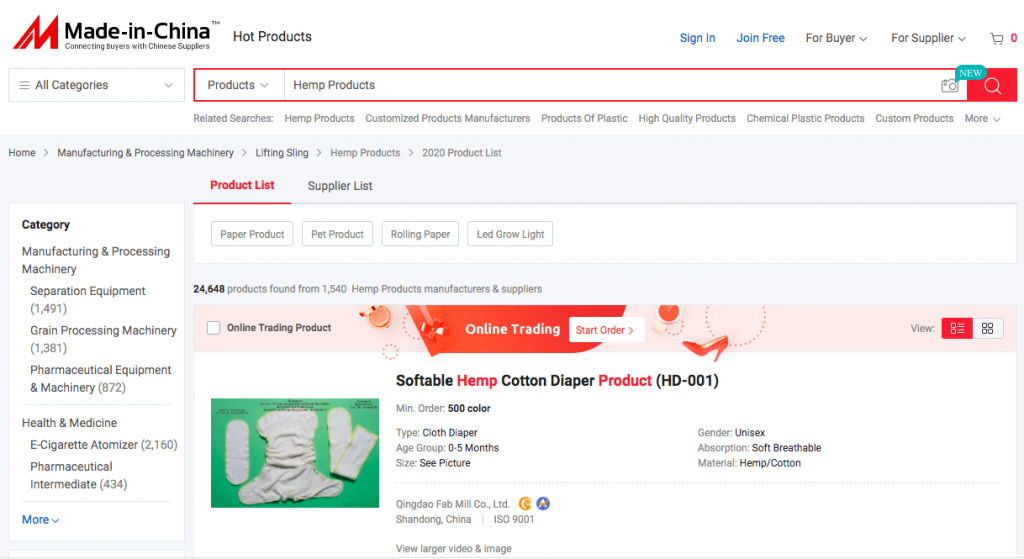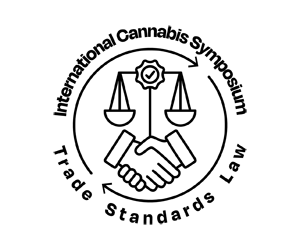Here at CLR we have been increasingly hearing stories in 2020 of hemp imported into the US from China that doesn’t end up being what the seller says it is.
The issue, it appears, is a touchy subject with various organisations and it has been hard for CLR to obtain clear evidence of what mills and related businesses are being sold product under the guise of hemp that actually ends up being something else entirely.
A reliable US source has recently supplied us with some testing results for material imported from China and sold to them as hemp.
Here’s what the test results show
In 2 out out of the 3 tests the material was shown to be 100% hemp and the third a hemp cotton mix
A quick couple of searches on google reveals the made in China website currently lists 24,648 products found from 1,540 Hemp Products manufacturers & suppliers (click on image to start exploring)
It seems about every conceivable thing you can think of is made from “hemp” in China these days !
How about some rolling papers ?
Except we say, buyer beware, remember this story from only a couple of weeks back Lead In Rolling Papers Says Californian Testing Lab
Love furry feline friends? Maybe you need this
Or.. Christmas is coming…
As you can imagine we could go on forever listing products that quite obviously have never been anywhere near a hemp plant and this, we gather, applies to wholsale “hemp” materials being sent to the US for processing into products.
So… where to start ?
How about this Arcview report published in conjunction with Asia Horizon in August 2020 extolling the virtues of chinese cbd & hemp based products
We warn you .. there’s 48 pages of this sort of gumph..
The combination of seismic demographic shifts, expansion in discretionary incomes, and unique domestic infrastructure contributes to China leading global spend across multiple consumer product categories, including those impacted by CBD such as beauty, alcohol, and tobacco. As further explored in this report, we anticipate that China will continue to evolve its legal framework for hemp-derived cannabinoids with a pragmatic regulatory approach. With consumer demand growing internationally, and awareness of CBD increasing domestically, we believe China is on track to eventually become the largest nonTHC cannabinoid market in the world
China-A-Rising-CBD-Superpower-August-2020-Whitepaper
Here’s a bit of background on Asia Horizon
At Linked In (click on image)
Their CEO who unsurprisingly worked at Arcview from Feb 2018 – Aug 2019
Website Hemp IM published an article early 2019 entitled, “How China Discreetly Became a Hemp Superpower” which gives us some background on why export is so important & valuable to China’s hemp sector and why going forward it’s going to prove difficult to unravel some of the issues related to the veracity of exported product
ARTICLE HIGHLIGHTS
By 2017, hemp farming has become one of China’s most important industries. Hemp has been one of the country’s most valuable crops. For context, a hectare of hemp farm can bring in an income of around $1,500 for farmers. It has even become more central to the country’s agriculture sector than corn.
In the same year (2017), China sold a total of $1.1 billion of hemp, which was close to almost a third of the $3.1 billion global markets for hemp. Of this, textiles accounted for about three-fourths of China’s exports, amounting to $832 million while CBD derived from hemp accounted for $53 million of the country’s exports.
Still, only hemp cultivation and export are legal in the country. Any form of consumption of the compound derived from hemp and marijuana remains illegal; not even medical marijuana is allowed in the country. To be even more specific, hemp cultivation is only legal in the southern province of Yunnan and in the northern province of Heilongjiang.
…/… The year 2019 opens with Chinese hemp-related stocks surging to historic highs. Shares of Shanghai Shunho New Materials Technology rose 433 percent just within the last three months into the year. The stock reached a record high when the manufacturer of packaging products announced that it also secured a hemp license.
Shares of Jilin Zixin Pharmaceutical Industrial also soared 201 percent this year. The jump took place after the maker of traditional Chinese medicine announced a partnership with Jilin Academy.
Surge of hemp stocks prompts government’s crackdown.
By the end of March, the Shenzhen Stock Exchange sent letters to hemp-related companies that reflected extraordinary trading activities. Of particular concern was when brokerage house Tibet Orient Fortune Securities bought $30.3 billion of Shunho shares in February. It also sold millions of Shunho stocks in the same month. At the same time, brokerage house China Galaxy Securities engaged in a large volume of buying and selling of Jilin Zixins shares.
Caixin, a Beijing-based media group providing financial and business news, highlights the large volume of buying and selling. This usually indicates that there is market manipulation. This usually happens with investors buying and selling the same stock so they could indirectly convince others to do the same.
The letters sent to Jilin Zixin and Shunho also asked both companies to clarify its announcements regarding their respective ventures in industrial hemp. The stock exchange was particularly concerned that investors were only reacting based on speculative trading.
The surge in stocks also prompted the China National Narcotic Control Commission to mandate drug authorities to be stricter with their issuance of licenses for industrial hemp.
Is China’s hemp industry nearing its demise?
The attention is still largely on the United States as analysts believe it remains to be the largest market for hemp and cannabis. However, the Global State Of Hemp: 2019 Industry Outlook released in March highlighted that the U.S still lags behind Canada and China with regard to cultivation. The 165 percent increase in the U.S. acreage is only a fraction of what China or Canada has separately.
The figures are particularly interesting in China since the country has no local consumers, to begin with. By contrast, Canada has both recreational and medical users as target consumers.
This suggests that China’s core consumers are based internationally or that the country’s reach spans across the world. And while analysts say that the U.S. and Canada are the largest markets to date, these two powerhouses could actually be relying on China for their supplies.
The Asian country may have long been the quiet superpower within the worldwide hemp industry, however, with no specific data and numbers available compared to the public statistics in the US and Canada, no one can really confirm this. Meanwhile, China’s recent government crackdowns can actually hold back the country’s rise as a leader in hemp. The country’s hemp industry growth is still stunted, so its fully maximized economic and market potential remains unknown.
Source: https://hemp.im/china-discreetly-hemp-superpower/
In April 2020 Harris Bricken law firm published this snippet that’s worth highlighting because it implies that issues such as veracity, product testing and trustworthy supply chains are going to become ever more important as Chinese investors in cannabis, CBD & hemp go international
HB write..
Companies in Africa and Asia (especially China) tend to have both money and real estate in their home countries and are focused on cannabis cultivation and, to a lesser extent, processing. Some of the most mature cannabis companies in China are extremely well capitalized and have the backing of significant governmental organizations. Even where cannabis is illegal (or partly illegal) in their home countries, they can get regulatory approvals to grow cannabis and produce products for export markets. They are often experienced growers and manufacturers of other products (such as hemp in textiles or consumer products like beverages) and are turning that expertise to the consumer cannabis market. They want to learn more and do more, and they are engaging with U.S. researchers and companies to do so. They know they need to find local partners to help them navigate the tangles of importing in those countries because they have often been turned away by U.S. customs.
Companies and individuals in the U.S. and in international markets may not fully grasp some of these nuances of why the U.S. market is attractive for international cannabis companies:
- The U.S. consumer market is well-educated on the benefits of cannabis and cannabis-derived products.
- The U.S. regulatory market is advancing and providing more certainty with new federal and state regulations being issued constantly.
- The U.S. consumer market is fractured, providing opportunities for both consolidation and new entrants with niche products.
- The U.S. has the technology infrastructure and strong rule of law, providing incentives for innovation and a legal basis to protect and enforce contractual obligations.
- The U.S. legalized hemp in 2018, leading to a hemp-derived cannabinoid marketplace that is rapidly eclipsing the legal adult-use marijuana market.
- Distressed U.S. cannabis companies that were struggling before COVID-19 are still looking for strategic partners and capital.
Based on our current clientele and projects, as well as the volume of international cannabis inquiries, we see the international cannabis market continuing to grow substantially in 2020 and beyond, even as so many emerging markets will decline due to the economic fallout from COVID-19. Though no company or industry seems to be immune from the effects of COVID-19, companies engaging in international cannabis will continue to seize new opportunities for growth, partnerships, and investments across international borders. We will keep you informed with more developments on the international cannabis scene. The world is big, so let us know if you are interested in learning more about any particular international markets.
China will not be going away, and Chinese companies are rapidly working to transition from growing low-CBD strains that are useful mainly in a textile manufacturing supply chains to high-CBD strains, and they are courting businesses and university R&D labs to get those strains. It will not be long before Made in China hemp and cannabinoids derived from that hemp can compete toe to toe with the best U.S. hemp strains.
This is the first of a number of articles we will be publishing on the Chinese hemp sector and especially with regard to export supply chains & product quality.
The puzzle, as with most things China, is increasingly hard to piece together but a narrative is beginning to appear that suggests anybody dealing with Chinese suppliers or agents of Chinese suppliers should start writing into contracts far more stringent clauses with regard to testing, ability to return product and most importantly the ability to pay for that product only after testing is undertaken.
More to come

























